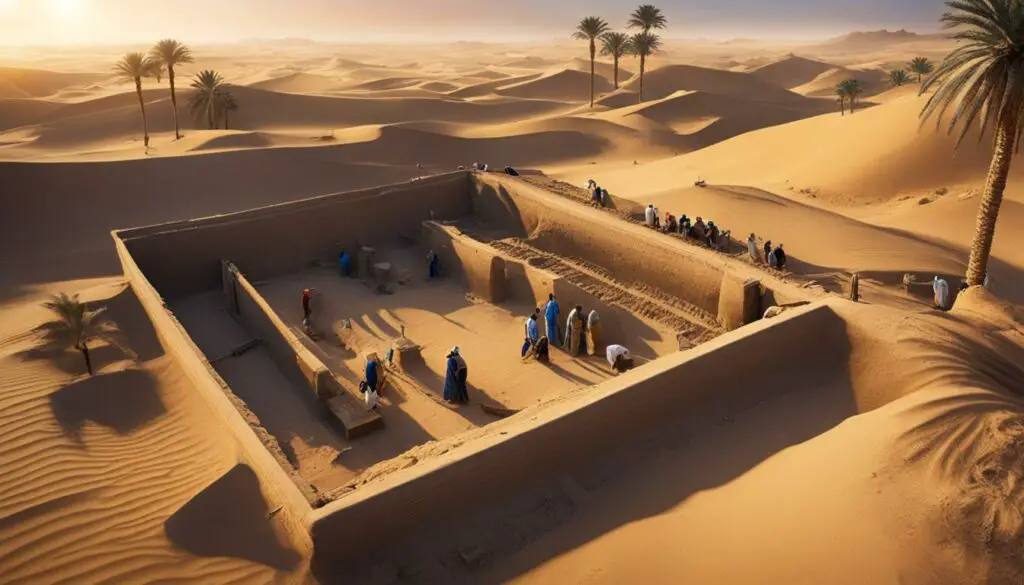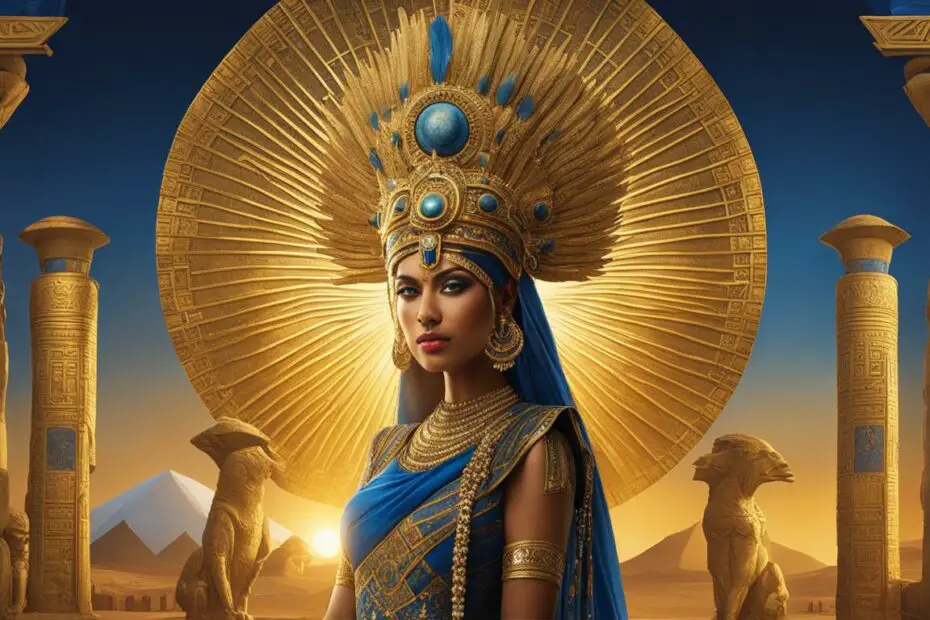Are there still pharaohs in Egypt? The answer may surprise you. While ancient Egyptian pharaohs ruled thousands of years ago, there is no direct lineage of modern-day pharaohs. However, the rich history and legacy of these ancient rulers continue to captivate scholars and enthusiasts alike.
Thanks to advancements in technology, we have been able to gain fascinating insights into the lives of ancient Egyptian pharaohs. For instance, radiologist Sahar Saleem used 3D computed tomography scanning technology to digitally unwrap the mummified body of pharaoh Amenhotep I, providing detailed information about his appearance.
Amenhotep I, the second king of the 18th dynasty, ruled Egypt for approximately 21 years. Despite his significant reign, his tomb remains undiscovered, and his mummified body currently rests in the Egyptian Museum in Cairo.
While there are no modern-day pharaohs in Egypt, the ancient Egyptian pharaohs continue to leave an enduring mark on history, sparking ongoing discoveries and research that shed light on their rule and civilization.
Insights into Ancient Egyptian Pharaohs and Archaeological Discoveries
The reign of Tutankhamun and recent archaeological discoveries have provided valuable insights into ancient Egyptian pharaohs and their lineage. Egyptologists continue to unearth fascinating artifacts and uncover hidden tombs, shedding light on the lives and legacies of ruling pharaohs and their successors.
Excavating the Lost Golden City
One of the most remarkable discoveries in recent years is the uncovering of the “lost golden city” near Luxor. This ancient city, known as Aten, dates back to the reign of Amenhotep III and was later used by pharaohs Ay and Tutankhamun. The excavation of Aten has yielded a wealth of valuable artifacts, including jewelry, pottery, and scarab beetle amulets. These findings offer a glimpse into the daily life, customs, and culture of ancient Egyptians during the time of ruling pharaohs.
Tutankhamun: A Window into the Pharaoh’s World
Tutankhamun’s tomb, discovered in 1922 by archaeologist Howard Carter, remains one of the most iconic archaeological finds in history. The treasures found within his tomb, including his elaborate golden burial mask, provide a rare glimpse into the opulence and grandeur of ancient Egyptian pharaohs. The artifacts found in Tutankhamun’s tomb have helped unravel mysteries surrounding the pharaoh’s life, royal lineage, and religious beliefs.
The Legacy of Ancient Pharaohs
Through ongoing research and excavation efforts, we continue to deepen our understanding of the ancient Egyptian monarchy and its pharaoh lineage. Each new discovery adds another puzzle piece to the intricate story of Egypt’s ancient past. The insights gained from studying the ruling pharaohs and their successors bring us closer to unraveling the mysteries of this fascinating civilization and its enduring legacy.
| Pharaoh | Reign | Notable Achievements |
|---|---|---|
| Tutankhamun | 1332 – 1323 BCE | Restored traditional religious practices, expanded trade |
| Amenhotep III | 1391 – 1353 BCE | Constructed magnificent temples, strengthened diplomatic ties |
| Ay | 1323 – 1319 BCE | Maintained stability during a turbulent period |
The Role of Archaeologists in Uncovering Egypt’s Ancient Past
The work of modern-day archaeologists in Egypt has been instrumental in unearthing and deciphering the mysteries of the country’s ancient past. Through their meticulous excavations and research, these dedicated professionals have made significant historical discoveries and shed light on the lives of ancient Egyptians.
One of the primary goals of archaeologists is to identify and explore excavation sites that hold the potential for uncovering valuable artifacts and remnants of ancient civilizations. These sites can range from burial grounds and temples to cities and settlements. By carefully excavating these areas and analyzing the artifacts and structures they unearth, archaeologists can piece together the puzzle of Egypt’s rich history.
Historical discoveries made by archaeologists have provided invaluable insights into the culture, customs, and achievements of ancient Egyptians. The excavation of tombs belonging to pharaohs and other prominent figures has revealed intricate burial rituals and the opulence of ancient Egyptian society. Artifacts such as statues, pottery, and jewelry offer glimpses into daily life, religious practices, and artistic expression during different eras.
Moreover, the work of archaeologists helps to preserve and protect Egypt’s ancient sites for future generations. Through careful excavation techniques and documentation, these professionals ensure that artifacts are handled and stored in a way that prevents deterioration or damage. By understanding the historical context and significance of these sites, archaeologists can also contribute to the development of strategies for sustainable tourism and cultural heritage management.
| Excavation Sites | Notable Discoveries |
|---|---|
| Valley of the Kings | Tombs of Tutankhamun, Ramses II, and Hatshepsut |
| Giza Necropolis | Great Sphinx, Pyramids of Giza, Solar Boat |
| Abydos | Temple of Seti I, Abydos King List |
| Karnak | Great Hypostyle Hall, Temple of Amun-Ra |
In conclusion, the tireless efforts of modern-day archaeologists have played a crucial role in uncovering the ancient past of Egypt. Through their excavations, historical discoveries, and preservation work, these dedicated professionals have contributed to our understanding of ancient Egyptian civilization and enriched our knowledge of human history.

The Impact of Ancient Egyptian Heritage on Modern Egypt
Ancient Egyptian heritage holds immense cultural and economic value for modern-day Egypt. The country’s rich history, with its iconic pharaohs, magnificent pyramids, and ancient temples, plays a crucial role in shaping Egypt’s cultural identity and attracting tourists from around the world.
Tourism in Egypt heavily relies on the preservation and promotion of its ancient sites and artifacts. Visitors are captivated by the opportunity to explore the wonders of ancient Egypt, immersing themselves in the splendor of the past and gaining a deeper appreciation for the country’s heritage.
The recent procession of 22 mummies through the streets of Cairo vividly showcased Egypt’s commitment to preserving and celebrating its ancient treasures. This grand event, along with ongoing efforts to revive tourism after political and pandemic disruptions, demonstrates the significance placed on ancient Egyptian heritage by the Egyptian government and people.
Preserving ancient sites and artifacts not only safeguards Egypt’s historical legacy but also fosters economic growth through tourism. By maintaining and showcasing its archaeological treasures, Egypt continues to attract visitors who contribute to the local economy, supporting jobs and infrastructure development. It is a delicate balance between preserving the past and ensuring sustainable tourism for the future.

The Economic Impact of Ancient Egyptian Heritage
The significance of ancient Egyptian heritage extends beyond cultural appreciation. The tourism sector, fueled by the allure of exploring historical wonders, plays a vital role in Egypt’s economy. According to the World Travel & Tourism Council, tourism contributes over 11% to Egypt’s GDP, providing jobs and income to millions of Egyptians.
By protecting and promoting its ancient sites, Egypt can leverage its unique cultural heritage to attract a steady stream of international visitors. From the awe-inspiring Pyramids of Giza to the majestic temples of Luxor and the tranquil beauty of the Nile, these ancient treasures form the backbone of Egypt’s tourism industry.
Challenges in Preserving Ancient Sites
Preserving ancient sites and artifacts comes with its set of challenges. The impact of tourism on fragile archaeological sites, such as wear and tear from foot traffic, is a significant concern. Striking a balance between accessibility and conservation is essential to ensure the long-term protection of these treasures.
Additionally, Egypt faces the ongoing threat of looting and illicit trade of antiquities, which can lead to the loss of invaluable artifacts. The Egyptian government, in collaboration with international organizations and law enforcement agencies, continues to combat the illicit trade to safeguard its ancient heritage.
The Future of Ancient Egyptian Heritage
The future of ancient Egyptian heritage relies on the continued efforts of preservation, research, and public engagement. Advancements in technology, such as 3D scanning and virtual reality, offer exciting opportunities to digitally preserve and explore ancient sites, making them accessible to a global audience.
By investing in sustainable tourism practices, community involvement, and education, Egypt can ensure the long-term viability of its ancient heritage. Ongoing collaborations between archaeologists, conservationists, and local communities will play a crucial role in preserving the past while embracing the future.
| Benefits of Preserving Ancient Egyptian Heritage | Challenges in Preserving Ancient Sites | The Future of Ancient Egyptian Heritage |
|---|---|---|
|
|
|
The Future of Ancient Egyptian Studies and Exploration
Advancements in Egyptology and scientific techniques in archaeology are set to shape the future of ancient Egyptian studies and exploration. The field continues to benefit from cutting-edge technology, allowing researchers to delve deeper into the mysteries of this ancient civilization.
One significant advancement is the utilization of non-invasive methods like 3D scanning and CT scanning. These techniques have revolutionized the study of mummies and artifacts, providing unprecedented insights into the lives of the pharaohs and their subjects. With these scientific tools, researchers can unravel the secrets held within ancient remains without causing any damage or disturbance.
Moreover, ongoing excavations and research projects hold immense potential for further discoveries. Archaeologists are tirelessly working to uncover hidden tombs, cities, and artifacts, which promise to expand our understanding of ancient Egypt. As these sites are unearthed, they offer valuable clues about the society, culture, and achievements of this remarkable civilization.
The future of ancient Egyptian studies is filled with exciting possibilities. As technology continues to advance, new scientific techniques will emerge, enabling researchers to explore even deeper into the past. By combining traditional archaeological methods with state-of-the-art technology, experts can uncover the truth about ancient Egypt and shed light on aspects that were once shrouded in mystery.
FAQ
Are there still pharaohs in Egypt?
No, there are no longer ruling pharaohs in modern-day Egypt. The last indigenous pharaoh was Cleopatra VII, who died in 30 BCE.
What insights have archaeological discoveries provided about ancient Egyptian pharaohs?
Archaeological discoveries have provided insights into the ancient Egyptian monarchy, including the pharaoh lineage, the ruling pharaohs of different dynasties, and the successors to the throne.
What has been the role of archaeologists in uncovering Egypt’s ancient past?
Archaeologists have played a vital role in the excavation and exploration of ancient Egyptian sites, including the discovery of the Valley of the Kings and various tombs of pharaohs. Their work has revealed important clues about the lives, customs, and achievements of ancient Egyptians.
How does ancient Egyptian heritage impact modern Egypt?
Ancient Egyptian heritage holds great significance for modern-day Egypt. It forms an integral part of the country’s cultural identity and plays a crucial role in attracting tourists from around the world. The preservation and promotion of ancient sites and artifacts are essential for the country’s tourism sector.
What does the future hold for ancient Egyptian studies and exploration?
As technology and scientific techniques continue to advance, the field of Egyptology and archaeological discoveries in Egypt are expected to evolve. Non-invasive methods like 3D scanning and CT scanning are revolutionizing the study of mummies and ancient artifacts. Ongoing excavations and research projects aim to uncover more hidden tombs, cities, and artifacts, providing further insights into the history and civilization of ancient Egypt.
